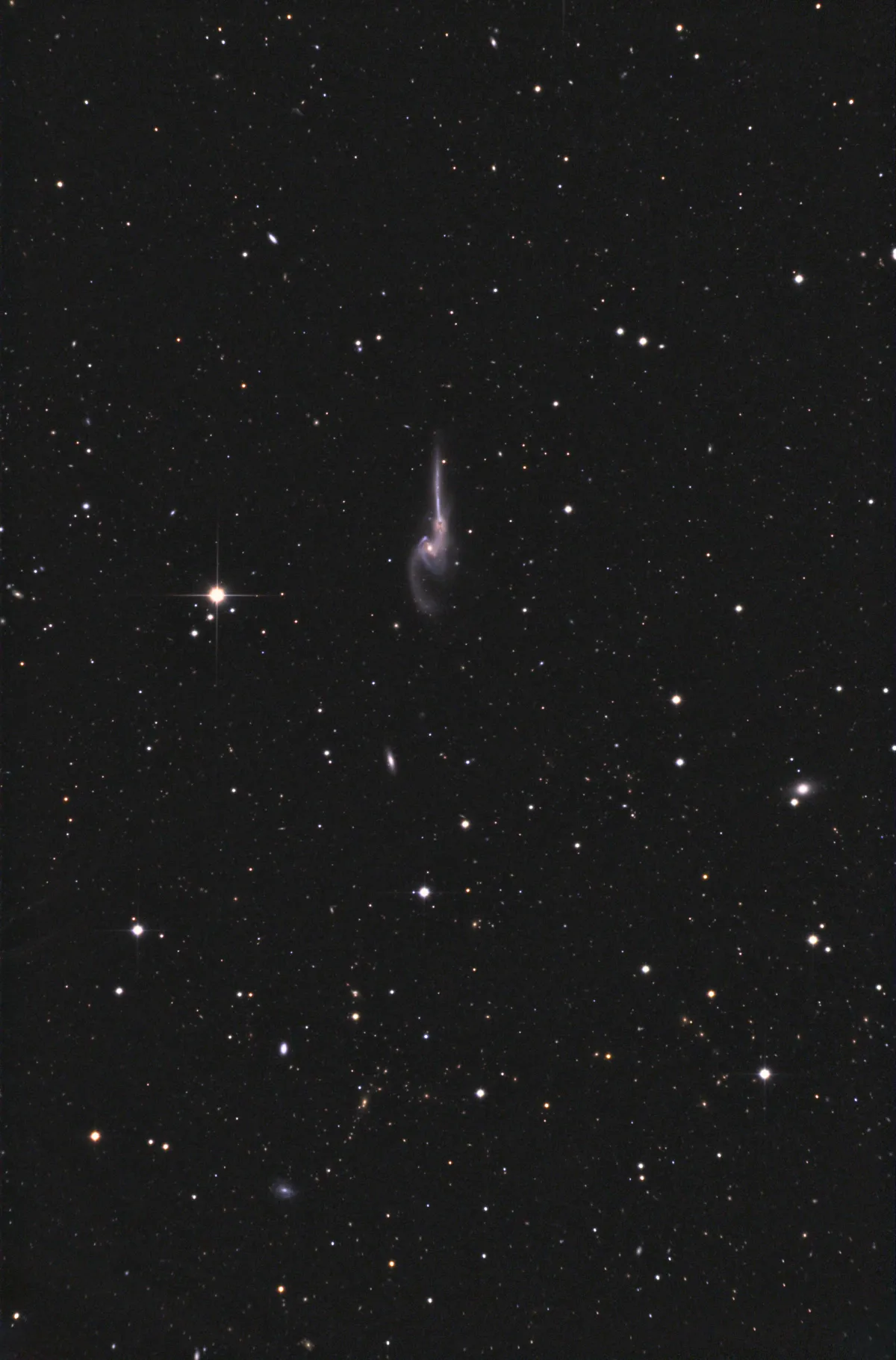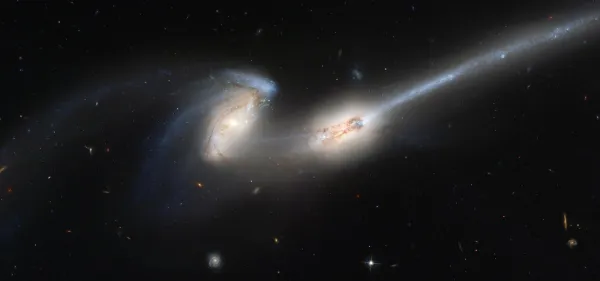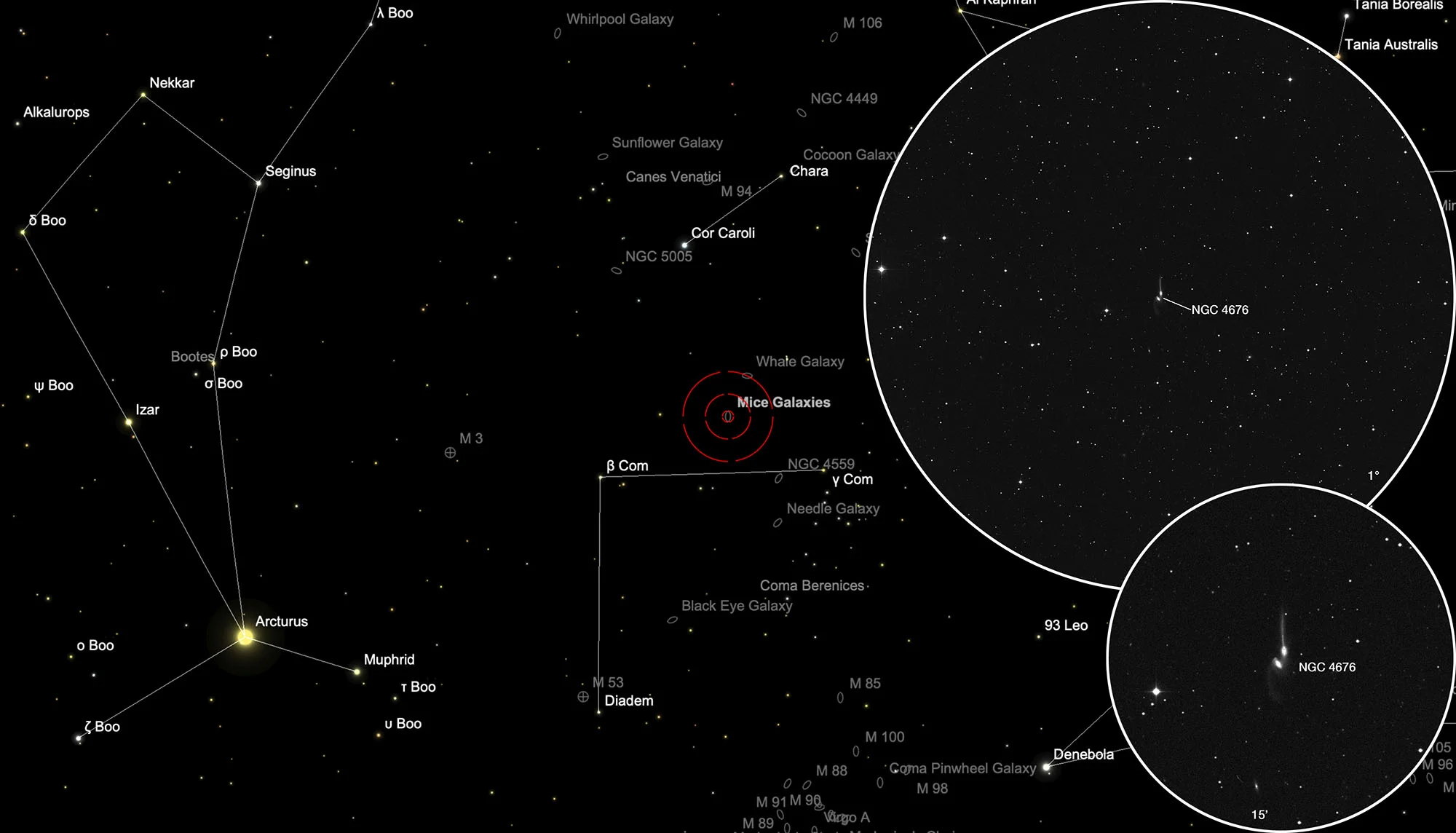Mice Galaxies (NGC 4676 A/B)

History
These two interacting Galaxies were first seen by William Herschel on 13 March 1785. As usual he was observing with his large his 18.7 inch reflecting telescope of 20 feet focal length, located in Slough, England. He cataloged it as II 326 and noted: «faint, much extended in the direction of the meridian.» [463] His son John cataloged it later as h 1425 (GC 3207) and thought he had seen two nucleus. He noted: «extremely faint, query if not bicentral». [466] John L. E. Dreyer added it 1888 as NGC 4676 in his «New General Catalogue». [313]
On 3 March 1892 the Austrian astronomer Rudolf Spitaler observed the same galaxy with the 27 inch refractor at Wien University Observatory. He saw two objects which were later added as IC 819 and IC 820 by Dreyer in his «Index Catalogue». He described both as «double nebula, connected, very faint, very small, south following, one brighter». [314] Because John Herschel described the nebula as having two nuclei and Spitaler listed them as two individual objects, they ended up as duplicate entries of NGC 4676 by mistake.
In Halton Arp's 1966 «Atlas of Peculiar Galaxies», the two interacting galaxies are listed as Arp 242 in the group #233-256 with «appearance of fission». [199]

Physical Properties
The distance to NGC 4676 A/B is given as 102 Mpc (circa 331 million light years). [145] These are two nearly identical spiral galaxies approximately 160 million years after their closest encounter. Gravitational forces have deformed their spirals into long, stretched tidal tails, giving the nickname «The Mice» for this interacting pair of galaxies. The long, stretched arm is actually curved. We see it edge-on why it appears straight. Simulations show that the pair will eventually merge and form a large elliptical galaxy. The stars, gas and luinous clusters of stars in the tidal tails will either fall into the merged galaxies or remain in a orbit in the halo. Our own Milky Way will probably look similar when it collides with our neighbour the Andromeda Galaxy (M 31) in several billion years from now. [476]
| Name | RA | Dec | Type | bMag | vMag | B-V | SB | Dim | PA | z | D(z) | Dreyer Description | Identification, Remarks |
|---|---|---|---|---|---|---|---|---|---|---|---|---|---|
| NGC 4676 A | 12 46 10.1 | +30 43 57 | Gx (SB0-a) | 14.4 | 13.5 | 0.9 | 13.2 | 1.4 × 0.6 | 0 | 0.022059 | 93.18 | vF, pmE, ? biN | WH II 326; h 1425; GC 3207; IC 819; UGC 7938; MCG 5-30-76; CGCG 159-72; VV 224; Arp 242; DFOT 59; KCPG 355A; The Mice |
| NGC 4676 B | 12 46 11.2 | +30 43 21 | Gx (S0-a) | 14.7 | 13.8 | 0.9 | 14.3 | 2.2 × 0.8 | 2 | 0.022039 | 93.09 | vF, pmE, ? biN | WH II 326; h 1425; GC 3207; IC 820; UGC 7939; MCG 5-30-77; CGCG 159-72; IRAS 12437+3059; KCPG 355B; Arp 242; VV 224; The Mice |
| IC 819 | 12 46 10.1 | +30 43 57 | dup | 14.4 | 13.5 | 0.9 | 13.2 | 1.4 × 0.6 | 0 | 0.022059 | 93.18 | D neb, conn, vF, vS, sf one brighter | NGC 4676A; UGC 7938; MCG 5-30-76; CGCG 159-72; VV 224; Arp 242; DFOT 59; KCPG 355A; The Mice |
| IC 820 | 12 46 11.2 | +30 43 21 | dup | 14.7 | 13.8 | 0.9 | 14.3 | 2.2 × 0.8 | 2 | 0.022039 | 93.09 | D neb, conn, vF, vS, sf one brighter | NGC 4676B; UGC 7939; MCG 5-30-77; CGCG 159-22; IRAS 12437+3059; KCPG 355B; Arp 242; VV 224; The Mice |
Finder Chart
The pair of galaxies can be found in the constellation Coma Berenices. Best observation time is in the months December to September.
Visual Observation

762 mm Aperture: The Mice Galaxies NGC 4676A+B have two different Mouse tails, more precisely tidal streams. The straight and brighter mouse tail is indirectly well visible and holding. The much fainter and curved one is probably wishful thinking, because the idea or image is already present in the mind. The stacked EAA image from 28 x 13s @ ISO 40000 single images still shows the second mouse tail quite faintly. — 30" f/3.3 SlipStream Dobsonian, Hasliberg, 04. 03. 2025, SQM-L 21.71, Eduard von Bergen
